Assessment of the Relationship between Land Use and Flood Risk Based on a Coupled Hydrological–Hydraulic Model: A Case Study of Zhaojue River Basin in Southwestern China
Abstract
:1. Introduction
2. Materials and Methods
2.1. Study Area and Data Description
2.2. Description of the Coupled Model
2.2.1. Hydrologic Component (XAJ)
2.2.2. Hydraulic Component (2D Model)
2.2.3. Coupled Component (Coupled Model)
2.3. Data Preprocessing and Model Calibration
2.4. Statistical Method
3. Results
3.1. Hydrological Characteristics and Land Use Change in the Study Area
3.2. Performance Assessment of Coupled Model for Real Flood Events
3.3. Flood Risk Response of Different Land Uses
4. Discussions
4.1. The Coupled Hydrological–Hydraulic Model and Flood Process
4.2. The Impact of Land Use and Topography on Flood Process
4.3. Strengths and Weaknesses
5. Conclusions
- (1)
- According to the analysis of hydrological characteristics (Section 3.1), it was concluded that the hydraulic and hydrologic features did not significantly change during the study period. The relationship between rainfall and runoff had a significant consistency. This was beneficial for coupled model application.
- (2)
- The results (Section 3.2) showed that the coupled model had a strong applicability to the basin in southwestern China. The model was able to reproduce observed hydrographs, and discharge was well simulated (Table 5 and Figure 7). We found that 80% of the flood events had an NSE value exceeding 0.70. In particular, the time of concentration and peak flows were well simulated: the simulated peak time matched well with the observed values with an error of less than ±3 h, and the PE values of most flood events were within 20%.
- (3)
- A unique advantage of the coupled model is that in addition to the flow hydrograph, it offers inundated area, water depth, and velocity information that is fundamental for reliable flood risk analysis. Our flood risk analysis results (Section 3.3) suggested that the coupled model is suitable for simulating inundation and could provide an important tool for flood management to reduce damage in terms of lives and property in the Zhaojue river basin.
- (4)
- The flood risk maps (Section 3.3) indicated that topography and land use played the most major roles in flood wave attenuation and delay. The flow velocity map (Figure 12a) showed that different land use types had different impacts on flood process. The order of flow velocity was as follows: forest < grassland < cultivated land < urban land. This order also reflected the degree of interception of floods by different land use types. These results showed that the strengthening of land management has played an important role in reducing flood risk.
Author Contributions
Funding
Institutional Review Board Statement
Informed Consent Statement
Data Availability Statement
Acknowledgments
Conflicts of Interest
References
- Wang, Y.T.; Chen, A.S.; Fu, G.T.; Djordjevic, S.; Zhang, C.; Savic, D.A. An integrated framework for high-resolution urban flood modelling considering multiple information sources and urban features. Environ. Modell. Softw. 2018, 107, 85–95. [Google Scholar] [CrossRef]
- Toosi, A.S.; Calbimonte, G.H.; Nouri, H.; Alaghmand, S. River basin-scale flood hazard assessment using a modified multi-criteria decision analysis approach: A case study. J. Hydrol. 2019, 574, 660–671. [Google Scholar] [CrossRef]
- Ceola, S.; Laio, F.; Montanari, A. Satellite nighttime lights reveal increasing human exposure to floods worldwide. Geophys. Res. Lett. 2014, 41, 7184–7190. [Google Scholar] [CrossRef]
- Dou, Y.H.; Ye, L.; Gupta, H.V.; Zhang, H.R.; Behrangi, A.; Zhou, H.C. Improved Flood Forecasting in Basins With No Precipitation Stations: Constrained Runoff Correction Using Multiple Satellite Precipitation Products. Water Resour. Res. 2021, 57, e2021WR029682. [Google Scholar] [CrossRef]
- Archer, D.R.; Fowler, H.J. Characterising flash flood response to intense rainfall and impacts using historical information and gauged data in Britain. J. Flood Risk Manag. 2018, 11, S121–S133. [Google Scholar] [CrossRef]
- Breinl, K.; Lun, D.; Muller-Thomy, H.; Bloschl, G. Understanding the relationship between rainfall and flood probabilities through combined intensity-duration-frequency analysis. J. Hydrol. 2021, 602, 126759. [Google Scholar] [CrossRef]
- Feng, B.Y.; Zhang, Y.; Bourke, R. Urbanization impacts on flood risks based on urban growth data and coupled flood models. Nat. Hazards 2021, 106, 613–627. [Google Scholar] [CrossRef]
- Smith, A.; Bates, P.D.; Wing, O.; Sampson, C.; Quinn, N.; Neal, J. New estimates of flood exposure in developing countries using high-resolution population data. Nat. Commun. 2019, 10, 1814. [Google Scholar] [CrossRef] [Green Version]
- Kesikoglu, M.H.; Atasever, U.H.; Dadaser-Celik, F.; Ozkan, C. Performance of ANN, SVM and MLH techniques for land use/cover change detection at Sultan Marshes wetland, Turkey. Water Sci. Technol. 2019, 80, 466–477. [Google Scholar] [CrossRef]
- Alfieri, L.; Bisselink, B.; Dottori, F.; Naumann, G.; de Roo, A.; Salamon, P.; Wyser, K.; Feyen, L. Global projections of river flood risk in a warmer world. Earths Future 2017, 5, 171–182. [Google Scholar] [CrossRef]
- Fang, G.H.; Yuan, Y.; Gao, Y.Q.; Huang, X.F.; Guo, Y.X. Assessing the Effects of Urbanization on Flood Events with Urban Agglomeration Polders Type of Flood Control Pattern Using the HEC-HMS Model in the Qinhuai River Basin, China. Water 2018, 10, 1003. [Google Scholar] [CrossRef] [Green Version]
- He, B.S.; Huang, X.L.; Ma, M.H.; Chang, Q.R.; Tu, Y.; Li, Q.; Zhang, K.; Hong, Y. Analysis of flash flood disaster characteristics in China from 2011 to 2015. Nat. Hazards 2018, 90, 407–420. [Google Scholar] [CrossRef]
- Liu, W.M.; Carling, P.A.; Hu, K.H.; Wang, H.; Zhou, Z.; Zhou, L.Q.; Liu, D.Z.; Lai, Z.P.; Zhang, X.B. Outburst floods in China: A review. Earth-Sci. Rev. 2019, 197, 102895. [Google Scholar] [CrossRef]
- Wei, L.; Hu, K.H.; Hu, X.D. Rainfall occurrence and its relation to flood damage in China from 2000 to 2015. J. Mt. Sci. 2018, 15, 2492–2504. [Google Scholar] [CrossRef]
- Glas, H.; Jonckheere, M.; Mandal, A.; James-Williamson, S.; De Maeyer, P.; Deruyter, G. A GIS-based tool for flood damage assessment and delineation of a methodology for future risk assessment: Case study for Annotto Bay, Jamaica. Nat. Hazards 2017, 88, 1867–1891. [Google Scholar] [CrossRef]
- Handayani, W.; Chigbu, U.E.; Rudiarto, I.; Putri, I.H.S. Urbanization and Increasing Flood Risk in the Northern Coast of Central Java-Indonesia: An Assessment towards Better Land Use Policy and Flood Management. Land 2020, 9, 343. [Google Scholar] [CrossRef]
- Diez-Herrero, A.; Garrote, J. Flood Risk Analysis and Assessment, Applications and Uncertainties: A Bibliometric Review. Water 2020, 12, 2050. [Google Scholar] [CrossRef]
- Kreibich, H.; Di Baldassarre, G.; Vorogushyn, S.; Aerts, J.C.J.H.; Apel, H.; Aronica, G.T.; Arnbjerg-Nielsen, K.; Bouwer, L.M.; Bubeck, P.; Caloiero, T.; et al. Adaptation to flood risk: Results of international paired flood event studies. Earths Future 2017, 5, 953–965. [Google Scholar] [CrossRef] [Green Version]
- Kim, J.; Warnock, A.; Ivanov, V.Y.; Katopodes, N.D. Coupled modeling of hydrologic and hydrodynamic processes including overland and channel flow. Adv. Water Resour. 2012, 37, 104–126. [Google Scholar] [CrossRef]
- Attems, M.S.; Thaler, T.; Genovese, E.; Fuchs, S. Implementation of property-level flood risk adaptation (PLFRA) measures: Choices and decisions. Wiley Interdiscip. Rev. Water 2020, 7, e1404. [Google Scholar] [CrossRef] [Green Version]
- Costache, R.; Bui, D.T. Identification of areas prone to flash-flood phenomena using multiple-criteria decision-making, bivariate statistics, machine learning and their ensembles. Sci. Total Environ. 2020, 712, 136492. [Google Scholar] [CrossRef] [PubMed]
- Wu, X.S.; Wang, Z.L.; Guo, S.L.; Liao, W.L.; Zeng, Z.Y.; Chen, X.H. Scenario-based projections of future urban inundation within a coupled hydrodynamic model framework: A case study in Dongguan City, China. J. Hydrol. 2017, 547, 428–442. [Google Scholar] [CrossRef]
- Lowe, R.; Urich, C.; Domingo, N.S.; Mark, O.; Deletic, A.; Arnbjerg-Nielsen, K. Assessment of urban pluvial flood risk and efficiency of adaptation options through simulations-A new generation of urban planning tools. J. Hydrol. 2017, 550, 355–367. [Google Scholar] [CrossRef] [Green Version]
- Mehr, A.D.; Kahya, E. A Pareto-optimal moving average multigene genetic programming model for daily streamflow prediction. J. Hydrol. 2017, 549, 603–615. [Google Scholar] [CrossRef]
- Fan, C.X.; An, R.D.; Li, J.; Li, K.F.; Deng, Y.; Li, Y. An Approach Based on the Protected Object for Dam-Break Flood Risk Management Exemplified at the Zipingpu Reservoir. Int. J. Environ. Res. Public Health 2019, 16, 3786. [Google Scholar] [CrossRef] [PubMed] [Green Version]
- Kumar, N.; Tischbein, B.; Kusche, J.; Beg, M.K.; Bogardi, J.J. Impact of land-use change on the water resources of the Upper Kharun Catchment, Chhattisgarh, India. Reg. Environ. Chang. 2017, 17, 2373–2385. [Google Scholar] [CrossRef]
- Hu, S.S.; Fan, Y.Y.; Zhang, T. Assessing the Effect of Land Use Change on Surface Runoff in a Rapidly Urbanized City: A Case Study of the Central Area of Beijing. Land 2020, 9, 17. [Google Scholar] [CrossRef] [Green Version]
- Yari, A.; Ardalan, A.; Ostadtaghizadeh, A.; Zarezadeh, Y.; Boubakran, M.S.; Bidarpoor, F.; Rahimiforoushani, A. Underlying factors affecting death due to flood in Iran: A qualitative content analysis. Int. J. Disaster Risk Reduct. 2019, 40, 101258. [Google Scholar] [CrossRef]
- Li, B.F.; Shi, X.; Lian, L.S.; Chen, Y.N.; Chen, Z.S.; Sun, X.Y. Quantifying the effects of climate variability, direct and indirect land use change, and human activities on runoff. J. Hydrol. 2020, 584, 124684. [Google Scholar] [CrossRef]
- Munoth, P.; Goyal, R. Impacts of land use land cover change on runoff and sediment yield of Upper Tapi River Sub-Basin, India. Int. J. River Basin Manag. 2020, 18, 177–189. [Google Scholar] [CrossRef]
- Li, Z.H.; Song, K.Y.; Peng, L. Flood Risk Assessment under Land Use and Climate Change in Wuhan City of the Yangtze River Basin, China. Land 2021, 10, 878. [Google Scholar] [CrossRef]
- Junger, L.; Hohensinner, S.; Schroll, K.; Wagner, K.; Seher, W. Land Use in Flood-Prone Areas and Its Significance for Flood Risk Management-A Case Study of Alpine Regions in Austria. Land 2022, 11, 392. [Google Scholar] [CrossRef]
- Iacob, O.; Brown, I.; Rowan, J. Natural flood management, land use and climate change trade-offs: The case of Tarland catchment, Scotland. Hydrolog. Sci. J. 2017, 62, 1931–1948. [Google Scholar] [CrossRef] [Green Version]
- Zhu, W.B.; Jia, S.F.; Lall, U.; Cao, Q.; Mahmood, R. Relative contribution of climate variability and human activities on the water loss of the Chari/Logone River discharge into Lake Chad: A conceptual and statistical approach. J. Hydrol. 2019, 569, 519–531. [Google Scholar] [CrossRef]
- Zheng, H.X.; Zhang, L.; Zhu, R.R.; Liu, C.M.; Sato, Y.; Fukushima, Y. Responses of streamflow to climate and land surface change in the headwaters of the Yellow River Basin. Water Resour. Res. 2009, 45, 7. [Google Scholar] [CrossRef]
- Oudin, L.; Salavati, B.; Furusho-Percot, C.; Ribstein, P.; Saadi, M. Hydrological impacts of urbanization at the catchment scale. J. Hydrol. 2018, 559, 774–786. [Google Scholar] [CrossRef] [Green Version]
- Zuo, D.P.; Xu, Z.X.; Yao, W.Y.; Jin, S.Y.; Xiao, P.Q.; Ran, D.C. Assessing the effects of changes in land use and climate on runoff and sediment yields from a watershed in the Loess Plateau of China. Sci. Total Environ. 2016, 544, 238–250. [Google Scholar] [CrossRef]
- Tong, L.; Dong, J.; Yuan, W.P. Effects of Precipitation and Vegetation Cover on Annual Runoff and Sediment Yield in Northeast China: A Preliminary Analysis. Water Resour. 2020, 47, 491–505. [Google Scholar] [CrossRef]
- Liu, J.B.; Gao, G.Y.; Wang, S.; Jiao, L.; Wu, X.; Fu, B.J. The effects of vegetation on runoff and soil loss: Multidimensional structure analysis and scale characteristics. J. Geogr. Sci. 2018, 28, 59–78. [Google Scholar] [CrossRef] [Green Version]
- Aghakhani, M.; Nasrabadi, T.; Vafaeinejad, A. Assessment of the Effects of Land Use Scenarios on Watershed Surface Runoff Using Hydrological Modelling. Appl. Ecol. Env. Res. 2018, 16, 2369–2389. [Google Scholar] [CrossRef]
- Han, Y.N.; Niu, J.Z.; Xin, Z.B.; Zhang, W.; Zhang, T.L.; Wang, X.L.; Zhang, Y.S. Optimization of land use pattern reduces surface runoff and sediment loss in a Hilly-Gully watershed at the Loess Plateau, China. Forest Syst. 2016, 25, e054. [Google Scholar] [CrossRef] [Green Version]
- Ran, J.; Nedovic-Budic, Z. Integrating spatial planning and flood risk management: A new conceptual framework for the spatially integrated policy infrastructure. Comput. Environ. Urban. 2016, 57, 68–79. [Google Scholar] [CrossRef] [Green Version]
- Li, C.C.; Cheng, X.T.; Li, N.; Du, X.H.; Yu, Q.; Kan, G.Y. A Framework for Flood Risk Analysis and Benefit Assessment of Flood Control Measures in Urban Areas. Int. J. Env. Res. Pub. Health 2016, 13, 787. [Google Scholar] [CrossRef] [PubMed] [Green Version]
- Tasantab, J.C. Beyond the plan: How land use control practices influence flood risk in Sekondi-Takoradi. Jamba-J. Disaster Ris. 2019, 11, 1–9. [Google Scholar] [CrossRef] [Green Version]
- Wheater, H.S. Progress in and prospects for fluvial flood modelling. Ser. A Math. Phys. Eng. Sci. 2002, 360, 1409–1431. [Google Scholar] [CrossRef] [PubMed]
- Zhou, Q.; Chen, L.; Singh, V.P.; Zhou, J.Z.; Chen, X.H.; Xiong, L.H. Rainfall-runoff simulation in karst dominated areas based on a coupled conceptual hydrological model. J. Hydrol. 2019, 573, 524–533. [Google Scholar] [CrossRef]
- Zhao, Y.M.; Liao, W.H.; Lei, X.H. Hydrological Simulation for Karst Mountain Areas: A Case Study of Central Guizhou Province. Water 2019, 11, 991. [Google Scholar] [CrossRef] [Green Version]
- Mo, C.X.; Wang, Y.F.; Ruan, Y.L.; Qin, J.K.; Zhang, M.S.; Sun, G.K.; Jin, J.L. The effect of karst system occurrence on flood peaks in small watersheds, southwest China. Hydrol. Res. 2021, 52, 305–322. [Google Scholar] [CrossRef]
- Guo, X.M.; Li, T.Y.; He, B.H.; He, X.R.; Yao, Y. Effects of land disturbance on runoff and sediment yield after natural rainfall events in southwestern China. Environ. Sci. Pollut. Res. 2017, 24, 9259–9268. [Google Scholar] [CrossRef] [PubMed]
- Zhao, Y.J.; Yang, N.; Wei, Y.P.; Hu, B.; Cao, Q.Z.; Tong, K.; Liang, Y.L. Eight Hundred Years of Drought and Flood Disasters and Precipitation Sequence Reconstruction in Wuzhou City, Southwest China. Water 2019, 11, 219. [Google Scholar] [CrossRef] [Green Version]
- Zounemat-Kermani, M.; Matta, E.; Cominola, A.; Xia, X.L.; Zhang, Q.; Liang, Q.H.; Hinkelmann, R. Neurocomputing in surface water hydrology and hydraulics: A review of two decades retrospective, current status and future prospects. J. Hydrol. 2020, 588, 125085. [Google Scholar] [CrossRef]
- Shin, S.; Pokhrel, Y.; Yamazaki, D.; Huang, X.D.; Torbick, N.; Qi, J.G.; Pattanakiat, S.; Thanh, N.D.; Tuan, N.D. High Resolution Modeling of River-Floodplain-Reservoir Inundation Dynamics in the Mekong River Basin. Water Resour. Res. 2020, 56, e2019WR026449. [Google Scholar] [CrossRef]
- Schumann, G.J.P.; Neal, J.C.; Voisin, N.; Andreadis, K.M.; Pappenberger, F.; Phanthuwongpakdee, N.; Hall, A.C.; Bates, P.D. A first large-scale flood inundation forecasting model. Water Resour. Res. 2013, 49, 6248–6257. [Google Scholar] [CrossRef]
- Wang, J.; Yun, X.B.; Pokhrel, Y.; Yamazaki, D.; Zhao, Q.D.; Chen, A.F.; Tang, Q.H. Modeling Daily Floods in the Lancang-Mekong River Basin Using an Improved Hydrological-Hydrodynamic Model. Water Resour. Res. 2021, 57, e2021WR029734. [Google Scholar] [CrossRef]
- Zischg, A.P.; Felder, G.; Mosimann, M.; Rothlisberger, V.; Weingartner, R. Extending coupled hydrological-hydraulic model chains with a surrogate model for the estimation of flood losses. Environ. Modell. Softw. 2018, 108, 174–185. [Google Scholar] [CrossRef]
- Senent-Aparicio, J.; Lopez-Ballesteros, A.; Nielsen, A.; Trolle, D. A holistic approach for determining the hydrology of the mar menor coastal lagoon by combining hydrological & hydrodynamic models. J. Hydrol. 2021, 603, 127150. [Google Scholar] [CrossRef]
- Munar, A.M.; Cavalcanti, J.R.; Bravo, J.M.; Fan, F.M.; da Motta-Marques, D.; Fragos, C.R. Coupling large-scale hydrological and hydrodynamic modeling: Toward a better comprehension of watershed-shallow lake processes. J. Hydrol. 2018, 564, 424–441. [Google Scholar] [CrossRef]
- Zhang, K.; Shalehy, M.H.; Ezaz, G.T.; Chakraborty, A.; Mohib, K.M.; Liu, L.X. An integrated flood risk assessment approach based on coupled hydrological-hydraulic modeling and bottom-up hazard vulnerability analysis. Environ. Modell. Softw. 2022, 148, 105279. [Google Scholar] [CrossRef]
- Nogherotto, R.; Fantini, A.; Raffaele, F.; Di Sante, F.; Dottori, F.; Coppola, E.; Giorgi, F. A combined hydrological and hydraulic modelling approach for the flood hazard mapping of the Po river basin. J. Flood Risk Manag. 2022, 15, e12755. [Google Scholar] [CrossRef]
- Chen, M.Y.; Li, Z.; Gao, S.; Luo, X.Y.; Wing, O.E.J.; Shen, X.Y.; Gourley, J.J.; Kolar, R.L.; Hong, Y. A Comprehensive Flood Inundation Mapping for Hurricane Harvey Using an Integrated Hydrological and Hydraulic Model. J. Hydrometeorol. 2021, 22, 1713–1726. [Google Scholar] [CrossRef]
- Xu, C.W.; Han, Z.Y.; Fu, H. Remote Sensing and Hydrologic-Hydrodynamic Modeling Integrated Approach for Rainfall-Runoff Simulation in Farm Dam Dominated Basin. Front. Environ. Sci. 2022, 9, 672. [Google Scholar] [CrossRef]
- Lai, X.J.; Jiang, J.H.; Liang, Q.H.; Huang, Q. Large-scale hydrodynamic modeling of the middle Yangtze River Basin with complex river-lake interactions. J. Hydrol. 2013, 492, 228–243. [Google Scholar] [CrossRef]
- Paiva, R.C.D.; Collischonn, W.; Tucci, C.E.M. Large scale hydrologic and hydrodynamic modeling using limited data and a GIS based approach. J. Hydrol. 2011, 406, 170–181. [Google Scholar] [CrossRef]
- Yin, J.; Yu, D.P.; Yin, Z.N.; Wang, J.; Xu, S.Y. Multiple scenario analyses of Huangpu River flooding using a 1D/2D coupled flood inundation model. Nat. Hazards 2013, 66, 577–589. [Google Scholar] [CrossRef]
- Lian, Y.Q.; Chan, I.C.; Singh, J.; Demissie, M.; Knapp, V.; Xie, H. Coupling of hydrologic and hydraulic models for the Illinois River Basin. J. Hydrol. 2007, 344, 210–222. [Google Scholar] [CrossRef]
- Barthelemy, S.; Ricci, S.; Morel, T.; Goutal, N.; Le Pape, E.; Zaoui, F. On operational flood forecasting system involving 1D/2D coupled hydraulic model and data assimilation. J. Hydrol. 2018, 562, 623–634. [Google Scholar] [CrossRef]
- Hoch, J.M.; Neal, J.C.; Baart, F.; van Beek, R.; Winsemius, H.C.; Bates, P.D.; Bierkens, M.F.P. GLOFRIM v1.0-A globally applicable computational framework for integrated hydrological-hydrodynamic modelling. Geosci. Model. Dev. 2017, 10, 3913–3929. [Google Scholar] [CrossRef] [Green Version]
- Grimaldi, S.; Petroselli, A.; Arcangeletti, E.; Nardi, F. Flood mapping in ungauged basins using fully continuous hydrologic-hydraulic modeling. J. Hydrol. 2013, 487, 39–47. [Google Scholar] [CrossRef]
- Emmanuel, I.; Andrieu, H.; Leblois, E.; Janey, N.; Payrastre, O. Influence of rainfall spatial variability on rainfall-runoff modelling: Benefit of a simulation approach? J. Hydrol. 2015, 531, 337–348. [Google Scholar] [CrossRef]
- Chavarri, E.; Crave, A.; Bonnet, M.P.; Mejia, A.; Da Silva, J.S.; Guyot, J.L. Hydrodynamic modelling of the Amazon River: Factors of uncertainty. J. South Am. Earth Sci. 2013, 44, 94–103. [Google Scholar] [CrossRef]
- Parvaze, S.; Khan, J.N.; Kumar, R.; Allaie, S.P. Flood forecasting in Jhelum river basin using integrated hydrological and hydraulic modeling approach with a real-time updating procedure. Clim. Dynam. 2022, 2022, 1–25. [Google Scholar] [CrossRef]
- Cao, Z.; Wang, X.; Pender, G.; Zhang, S. Hydrodynamic modelling in support of flash flood warning. Water Manag. 2010, 163, 327–340. [Google Scholar] [CrossRef]
- Li, H.; Beldring, S.; Xu, C.Y. Stability of model performance and parameter values on two catchments facing changes in climatic conditions. Hydrolog. Sci. J. 2015, 60, 1317–1330. [Google Scholar] [CrossRef] [Green Version]
- Costabile, P.; Costanzo, C.; Macchione, F. A storm event watershed model for surface runoff based on 2D fully dynamic wave equations. Hydrol. Process. 2013, 27, 554–569. [Google Scholar] [CrossRef]
- Zhang, L.; Lu, J.Z.; Chen, X.L.; Liang, D.; Fu, X.K.; Sauvage, S.; Perez, J.M.S. Stream flow simulation and verification in ungauged zones by coupling hydrological and hydrodynamic models: A case study of the Poyang Lake ungauged zone. Hydrol. Earth Syst. Sci. 2017, 21, 5847–5861. [Google Scholar] [CrossRef] [Green Version]
- Laganier, O.; Ayral, P.A.; Salze, D.; Sauvagnargues, S. A coupling of hydrologic and hydraulic models appropriate for the fast floods of the Gardon River basin (France). Nat. Hazards Earth Syst. Sci. 2014, 14, 2899–2920. [Google Scholar] [CrossRef] [Green Version]
- Lerat, J.; Perrin, C.; Andreassian, V.; Loumagne, C.; Ribstein, P. Towards robust methods to couple lumped rainfall-runoff models and hydraulic models: A sensitivity analysis on the Illinois River. J. Hydrol. 2012, 418, 123–135. [Google Scholar] [CrossRef] [Green Version]
- Yang, R.W.; Wang, J. Interannual variability of the seesaw mode of the interface between the Indian and East Asian summer monsoons. Clim. Dynam. 2019, 53, 2683–2695. [Google Scholar] [CrossRef]
- Li, Z.X.; He, Y.Q.; Wang, P.Y.; Theakstone, W.H.; An, W.L.; Wang, X.F.; Lu, A.G.; Zhang, W.; Cao, W.H. Changes of daily climate extremes in southwestern China during 1961–2008. Glob. Planet Chang. 2012, 80–81, 255–272. [Google Scholar] [CrossRef]
- Liu, M.X.; Xu, X.L.; Sun, A.Y.; Wang, K.L.; Liu, W.; Zhang, X.Y. Is southwestern China experiencing more frequent precipitation extremes? Environ. Res. Lett. 2014, 9, 064002. [Google Scholar] [CrossRef] [Green Version]
- Chen, X.; Zhang, Z.C.; Chen, X.H.; Shi, P. The impact of land use and land cover changes on soil moisture and hydraulic conductivity along the karst hillslopes of southwest China. Environ. Earth Sci. 2009, 59, 811–820. [Google Scholar] [CrossRef]
- Liu, M.X.; Xu, X.L.; Sun, A. Decreasing spatial variability in precipitation extremes in southwestern China and the local/large-scale influencing factors. J. Geophys. Res.-Atmos. 2015, 120, 6480–6488. [Google Scholar] [CrossRef]
- Zhao, R.J. The Xinanjiang Model Applied in China. J. Hydrol. 1992, 135, 371–381. [Google Scholar] [CrossRef]
- Lu, H.S.; Hou, T.; Horton, R.; Zhu, Y.H.; Chen, X.; Jia, Y.W.; Wang, W.; Fu, X.L. The streamflow estimation using the Xinanjiang rainfall runoff model and dual state-parameter estimation method. J. Hydrol. 2013, 480, 102–114. [Google Scholar] [CrossRef]
- Monajemi, P.; Khaleghi, S.; Maleki, S. Derivation of instantaneous unit hydrographs using linear reservoir models. Hydrol. Res. 2021, 52, 339–355. [Google Scholar] [CrossRef]
- Meehan, P.J. Flood Routing by the Muskingum Method-Comments. J. Hydrol. 1979, 41, 167–168. [Google Scholar] [CrossRef]
- Hou, J.M.; Simons, F.; Liang, Q.H.; Hinkelmann, R. An improved hydrostatic reconstruction method for shallow water model. J. Hydraul. Res. 2014, 52, 432–439. [Google Scholar] [CrossRef]
- Liang, Q.H.; Borthwick, A.G.L. Adaptive quadtree simulation of shallow flows with wet-dry fronts over complex topography. Comput. Fluids 2009, 38, 221–234. [Google Scholar] [CrossRef]
- Fiedler, F.R.; Ramirez, J.A. A numerical method for simulating discontinuous shallow flow over an infiltrating surface. Int. J. Numer. Methods Fluids 2000, 32, 219–240. [Google Scholar] [CrossRef]
- Wagner, P.D.; Fiener, P.; Wilken, F.; Kumar, S.; Schneider, K. Comparison and evaluation of spatial interpolation schemes for daily rainfall in data scarce regions. J. Hydrol. 2012, 464, 388–400. [Google Scholar] [CrossRef]
- Wang, Y.L.; Yang, X.L. A Coupled Hydrologic-Hydraulic Model (XAJ-HiPIMS) for Flood Simulation. Water 2020, 12, 1288. [Google Scholar] [CrossRef]
- Goegebeur, M.; Pauwels, V.R.N. Improvement of the PEST parameter estimation algorithm through Extended Kalman Filtering. J. Hydrol. 2007, 337, 436–451. [Google Scholar] [CrossRef]
- Li, H.X.; Zhang, Y.Q.; Chiew, F.H.S.; Xu, S.G. Predicting runoff in ungauged catchments by using Xinanjiang model with MODIS leaf area index. J. Hydrol. 2009, 370, 155–162. [Google Scholar] [CrossRef]
- Yao, C.; Zhang, K.; Yu, Z.B.; Li, Z.J.; Li, Q.L. Improving the flood prediction capability of the Xinanjiang model in ungauged nested catchments by coupling it with the geomorphologic instantaneous unit hydrograph. J. Hydrol. 2014, 517, 1035–1048. [Google Scholar] [CrossRef]
- Lin, K.R.; Lv, F.S.; Chen, L.; Singh, V.P.; Zhang, Q.; Chen, X.H. Xinanjiang model combined with Curve Number to simulate the effect of land use change on environmental flow. J. Hydrol. 2014, 519, 3142–3152. [Google Scholar] [CrossRef]
- Moriasi, D.N.; Gitau, M.W.; Pai, N.; Daggupati, P. Hydrologic and Water Quality Models: Performance Measures and Evaluation Criteria. Trans. ASABE 2015, 58, 1763–1785. [Google Scholar] [CrossRef] [Green Version]
- McGrane, S.J. Impacts of urbanisation on hydrological and water quality dynamics, and urban water management: A review. Hydrolog. Sci. J. 2016, 61, 2295–2311. [Google Scholar] [CrossRef]
- Nguyen, P.; Thorstensen, A.; Sorooshian, S.; Hsu, K.L.; AghaKouchak, A.; Sanders, B.; Koren, V.; Cui, Z.T.; Smith, M. A high resolution coupled hydrologic-hydraulic model (HiResFlood-UCI) for flash flood modeling. J. Hydrol. 2016, 541, 401–420. [Google Scholar] [CrossRef] [Green Version]
- Frei, S.; Fleckenstein, J.H. Representing effects of micro-topography on runoff generation and sub-surface flow patterns by using superficial rill/depression storage height variations. Environ. Modell. Softw. 2014, 52, 5–18. [Google Scholar] [CrossRef]
- Tyler, J.; Sadiq, A.A.; Noonan, D.S. A review of the community flood risk management literature in the USA: Lessons for improving community resilience to floods. Nat. Hazards 2019, 96, 1223–1248. [Google Scholar] [CrossRef]
- Dieperink, C.; Hegger, D.L.T.; Bakker, M.H.N.; Kundzewicz, Z.W.; Green, C.; Driessen, P.P.J. Recurrent Governance Challenges in the Implementation and Alignment of Flood Risk Management Strategies: A Review. Water Resour. Manag. 2016, 30, 4467–4481. [Google Scholar] [CrossRef] [Green Version]
- Komi, K.; Neal, J.; Trigg, M.A.; Diekkruger, B. Modelling of flood hazard extent in data sparse areas: A case study of the Oti River basin, West Africa. J. Hydrol.-Reg. Stud. 2017, 10, 122–132. [Google Scholar] [CrossRef] [Green Version]
- Wei, Z.W.; He, X.G.; Zhang, Y.G.; Pan, M.; Sheffield, J.; Peng, L.Q.; Yamazaki, D.; Moiz, A.; Liu, Y.P.; Ikeuchi, K. Identification of uncertainty sources in quasi-global discharge and inundation simulations using satellite-based precipitation products. J. Hydrol. 2020, 589, 125180. [Google Scholar] [CrossRef]
- Sindhu, K.; Rao, K.H.V.D. Hydrological and hydrodynamic modeling for flood damage mitigation in Brahmani-Baitarani River Basin, India. Geocarto Int. 2017, 32, 1004–1016. [Google Scholar] [CrossRef]
- Cheng, T.; Xu, Z.X.; Yang, H.; Hong, S.Y.; Leitao, J.P. Analysis of Effect of Rainfall Patterns on Urban Flood Process by Coupled Hydrological and Hydrodynamic Modeling. J. Hydrol. Eng. 2020, 25, 04019061. [Google Scholar] [CrossRef]
- Huang, W.; Cao, Z.X.; Qi, W.J.; Pender, G.; Zhao, K. Full 2D hydrodynamic modelling of rainfall-induced flash floods. J. Mt. Sci. 2015, 12, 1203–1218. [Google Scholar] [CrossRef]
- Wang, Y.L.; Liang, Q.H.; Kesserwani, G.; Hall, J.W. A 2D shallow flow model for practical dam-break simulations. J. Hydraul. Res. 2011, 49, 307–316. [Google Scholar] [CrossRef]
- Liang, Q.H.; Smith, L.S. A high-performance integrated hydrodynamic modelling system for urban flood simulations. J. Hydroinform. 2015, 17, 518–533. [Google Scholar] [CrossRef]
- Wing, O.E.J.; Bates, P.D.; Neal, J.C.; Sampson, C.C.; Smith, A.M.; Quinn, N.; Shustikova, I.; Domeneghetti, A.; Gilles, D.W.; Goska, R.; et al. A New Automated Method for Improved Flood Defense Representation in Large-Scale Hydraulic Models. Water Resour. Res. 2019, 55, 11007–11034. [Google Scholar] [CrossRef] [Green Version]
- Ajayi, A.E.; van de Giesen, N.; Vlek, P. A numerical model for simulating Hortonian overland flow on tropical hillslopes with vegetation elements. Hydrol. Process. 2008, 22, 1107–1118. [Google Scholar] [CrossRef]
- Wang, S.J.; Liu, Q.M.; Zhang, D.F. Karst rocky desertification in southwestern China: Geomorphology, landuse, impact and rehabilitation. Land Degrad. Dev. 2004, 15, 115–121. [Google Scholar] [CrossRef]
- Yu, C.W.; Hodges, B.; Liu, F. A new form of the Saint-Venant equations for variable topography. Hydrol. Earth Syst. Sci. 2020, 24, 4001–4024. [Google Scholar] [CrossRef]
- Possa, T.M.; Collares, G.L.; Boeira, L.D.; Jardim, P.F.; Fan, F.M.; Terra, V.S.S. Fully coupled hydrological-hydrodynamic modeling of a basin-river-lake transboundary system in Southern South America. J. Hydroinform. 2022, 24, 93–112. [Google Scholar] [CrossRef]
- Tanaka, T.; Yoshioka, H.; Siev, S.; Fujii, H.; Fujihara, Y.; Hoshikawa, K.; Ly, S.; Yoshimura, C. An Integrated Hydrological-Hydraulic Model for Simulating Surface Water Flows of a Shallow Lake Surrounded by Large Floodplains. Water 2018, 10, 1213. [Google Scholar] [CrossRef] [Green Version]
- Yamazaki, D.; de Almeida, G.A.M.; Bates, P.D. Improving computational efficiency in global river models by implementing the local inertial flow equation and a vector-based river network map. Water Resour. Res. 2013, 49, 7221–7235. [Google Scholar] [CrossRef]
- Hawker, L.; Uhe, P.; Paulo, L.; Sosa, J.; Savage, J.; Sampson, C.; Neal, J. A 30 m global map of elevation with forests and buildings removed. Environ. Res. Lett. 2022, 17, 024016. [Google Scholar] [CrossRef]
- Morita, M.; Yen, B.C. Modeling of conjunctive two-dimensional surface-three-dimensional subsurface flows. J. Hydraul. Eng. 2002, 128, 184–200. [Google Scholar] [CrossRef]
- Begnudelli, L.; Sanders, B.F. Simulation of the St. Francis dam-break flood. J. Eng. Mech. 2007, 133, 1200–1212. [Google Scholar] [CrossRef]
- Mersel, M.K.; Smith, L.C.; Andreadis, K.M.; Durand, M.T. Estimation of river depth from remotely sensed hydraulic relationships. Water Resour. Res. 2013, 49, 3165–3179. [Google Scholar] [CrossRef] [Green Version]
- Todini, E. Hydrological catchment modelling: Past, present and future. Hydrol. Earth Syst. Sci. 2007, 11, 468–482. [Google Scholar] [CrossRef] [Green Version]
- Li, W.J.; Lin, K.R.; Zhao, T.T.G.; Lan, T.; Chen, X.H.; Du, H.W.; Chen, H.Y. Risk assessment and sensitivity analysis of flash floods in ungauged basins using coupled hydr.rologic and hydrodynamic models. J. Hydrol. 2019, 572, 108–120. [Google Scholar] [CrossRef]
- Wang, W.; Lu, H.; Yang, D.W.; Sothea, K.; Jiao, Y.; Gao, B.; Peng, X.T.; Pang, Z.G. Modelling Hydrologic Processes in the Mekong River Basin Using a Distributed Model Driven by Satellite Precipitation and Rain Gauge Observations. PLoS ONE 2016, 11, e0152229. [Google Scholar] [CrossRef] [PubMed] [Green Version]
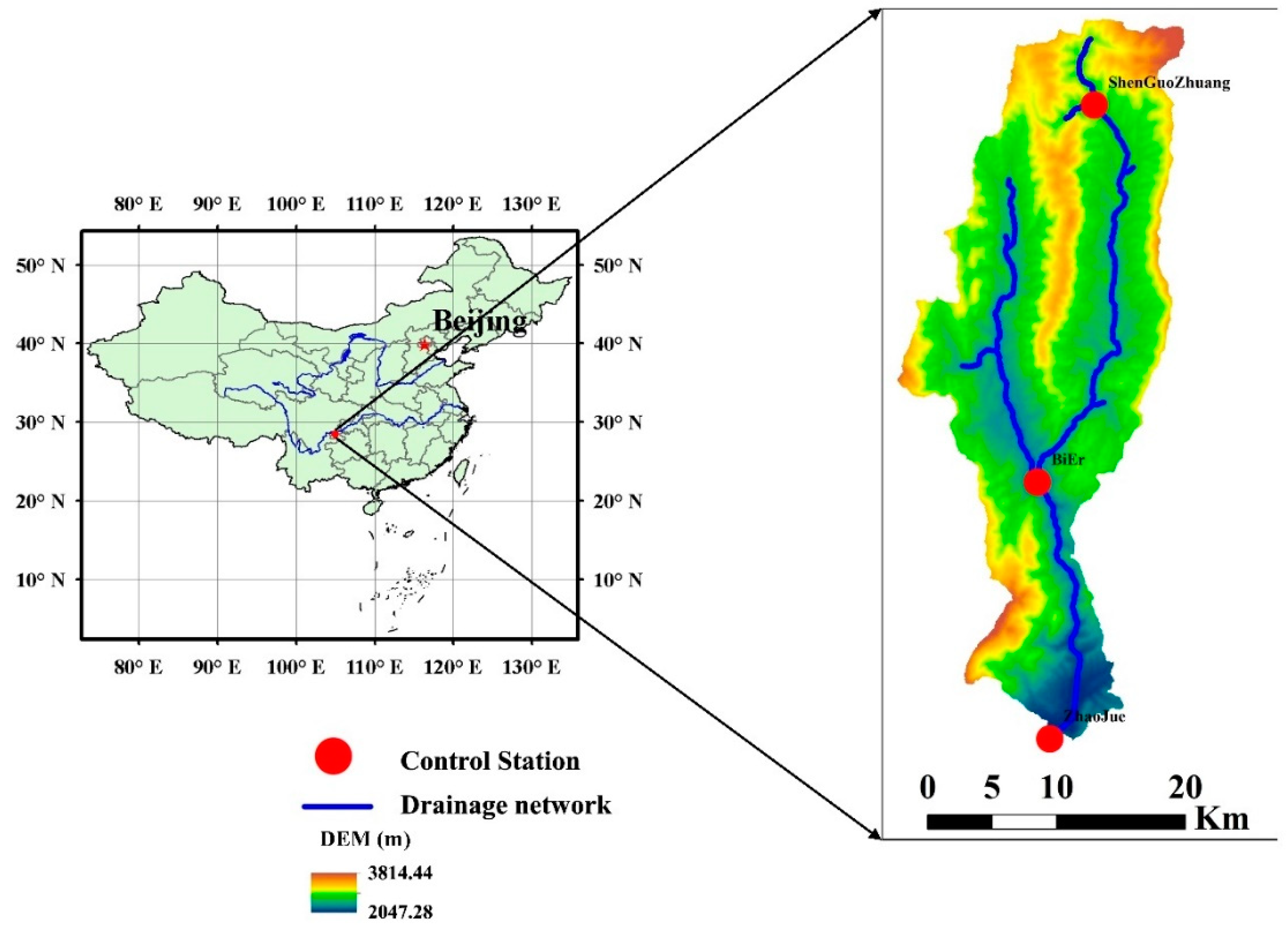
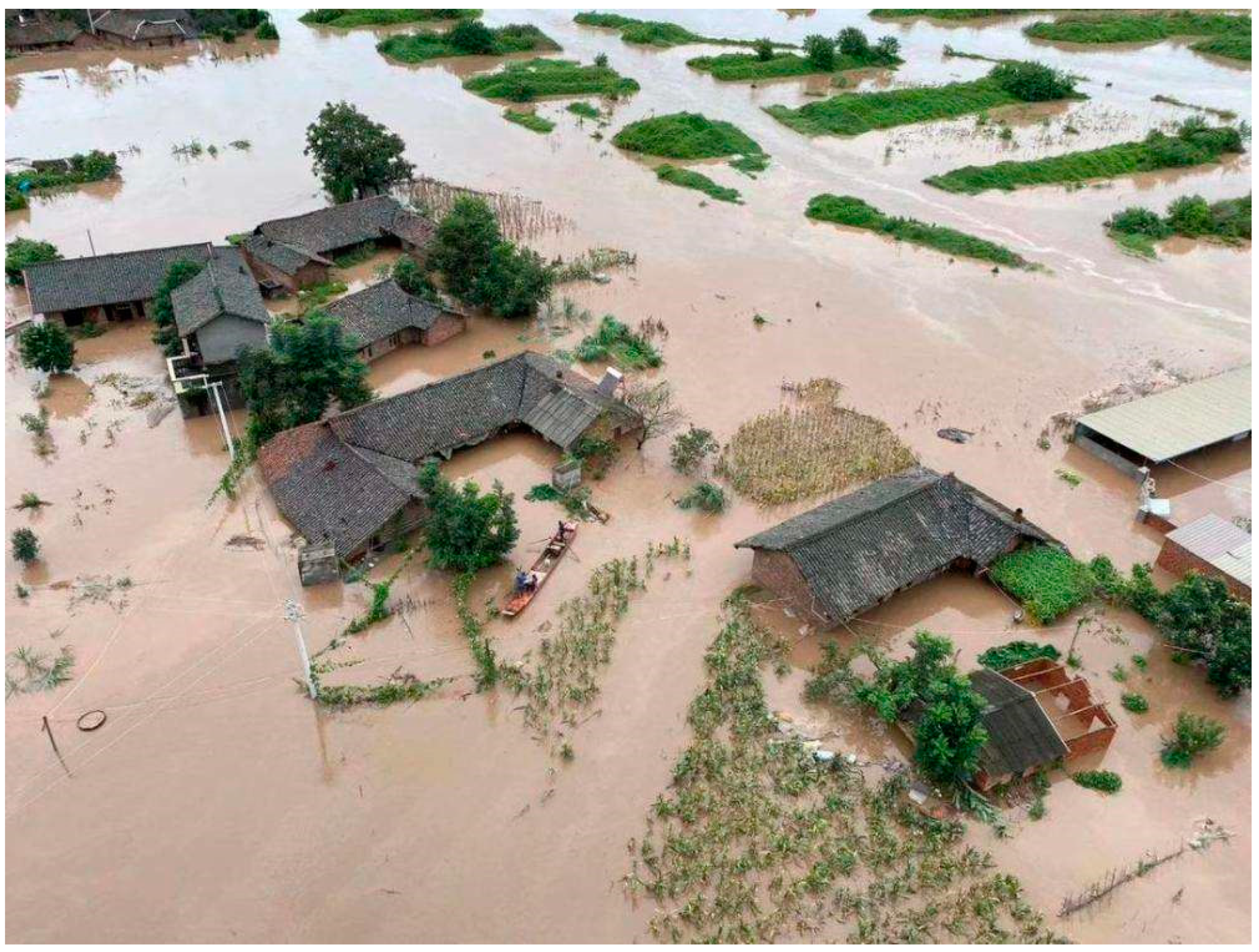
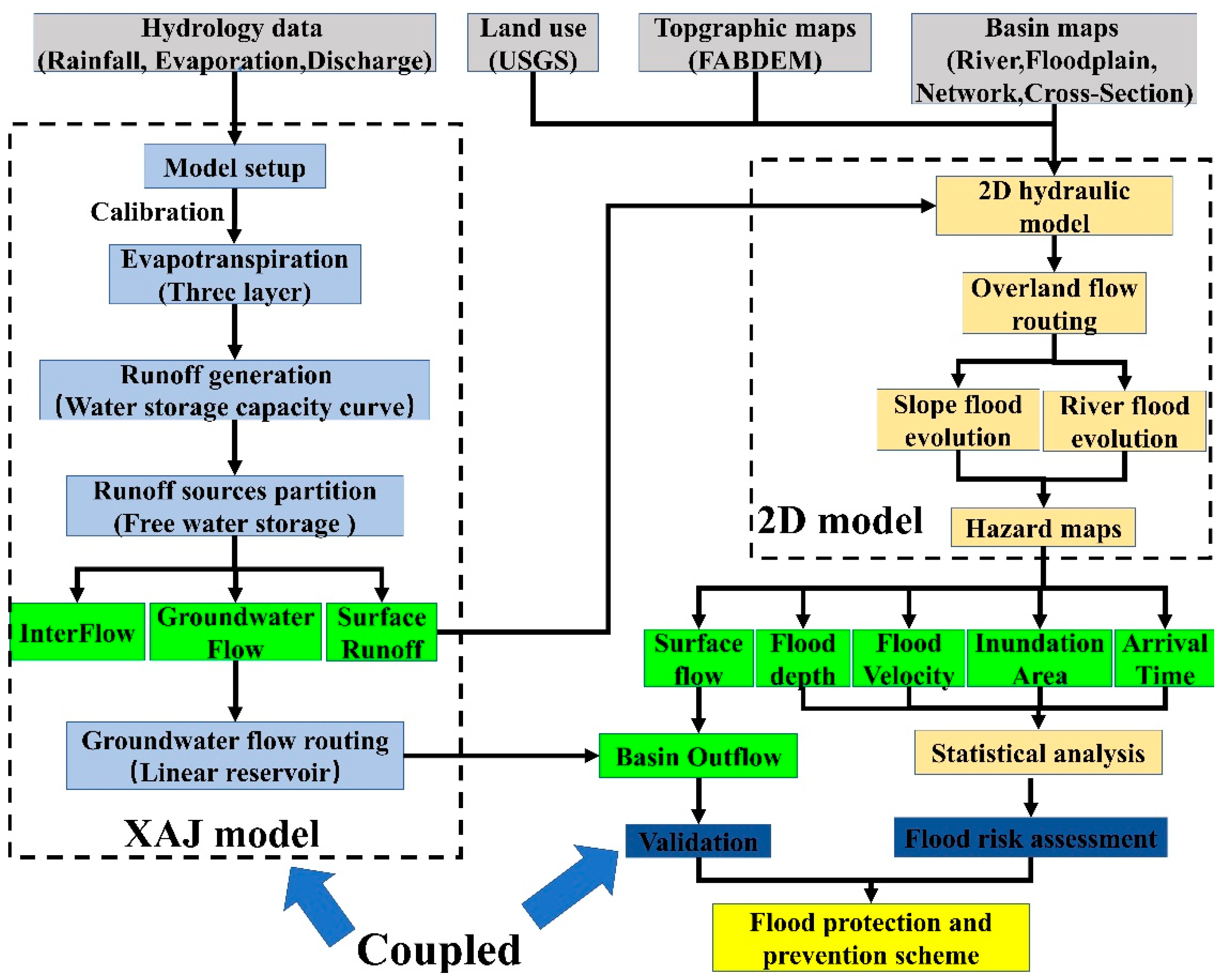

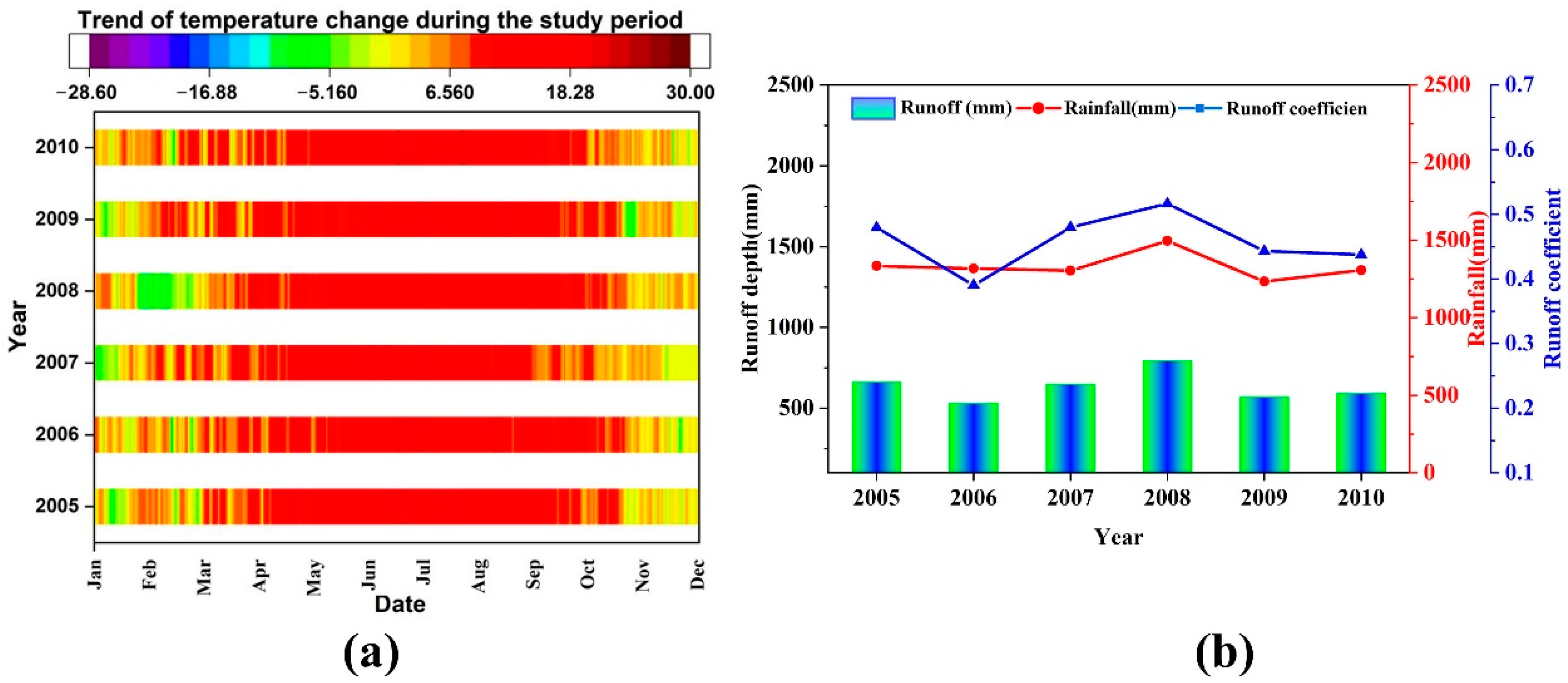
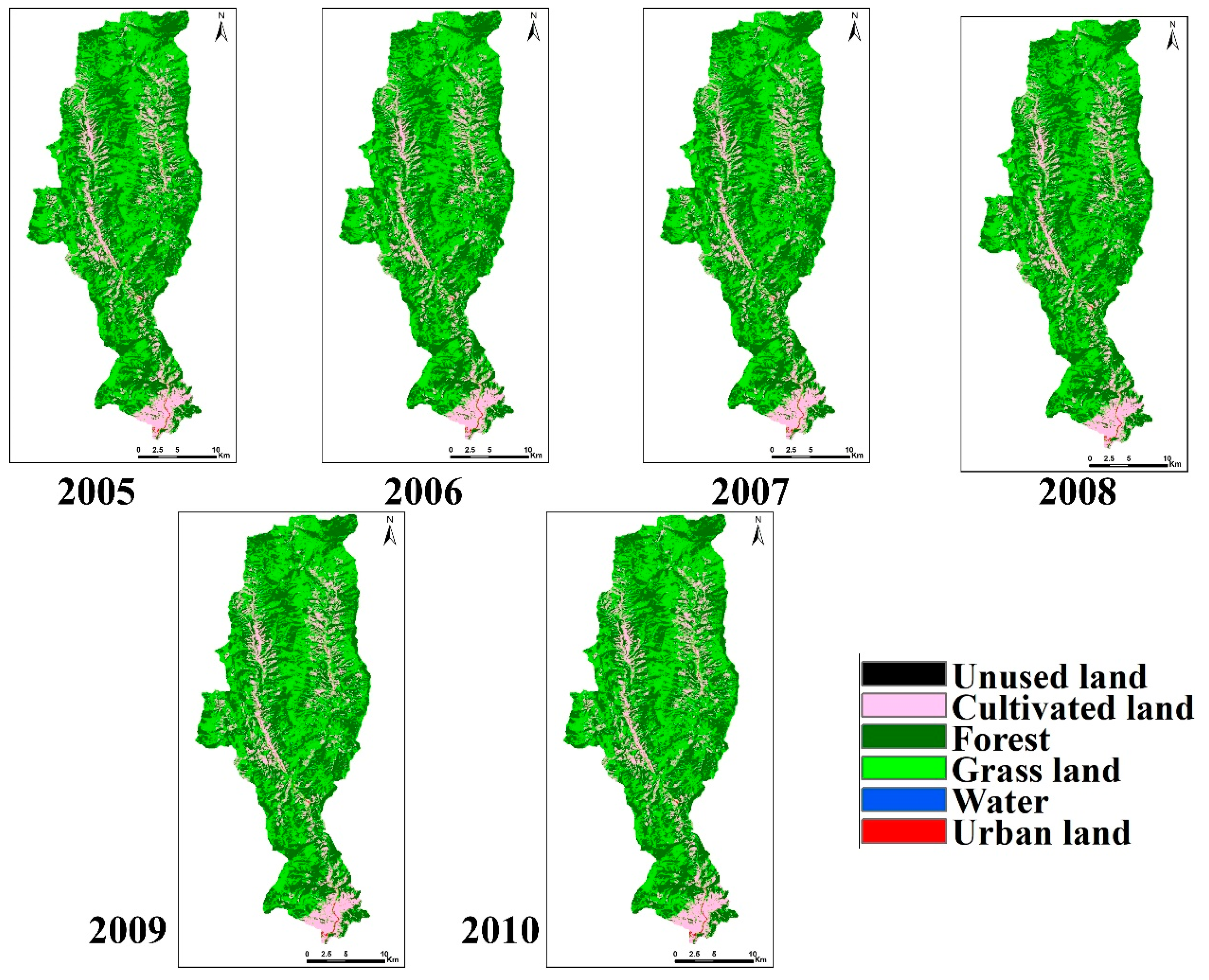
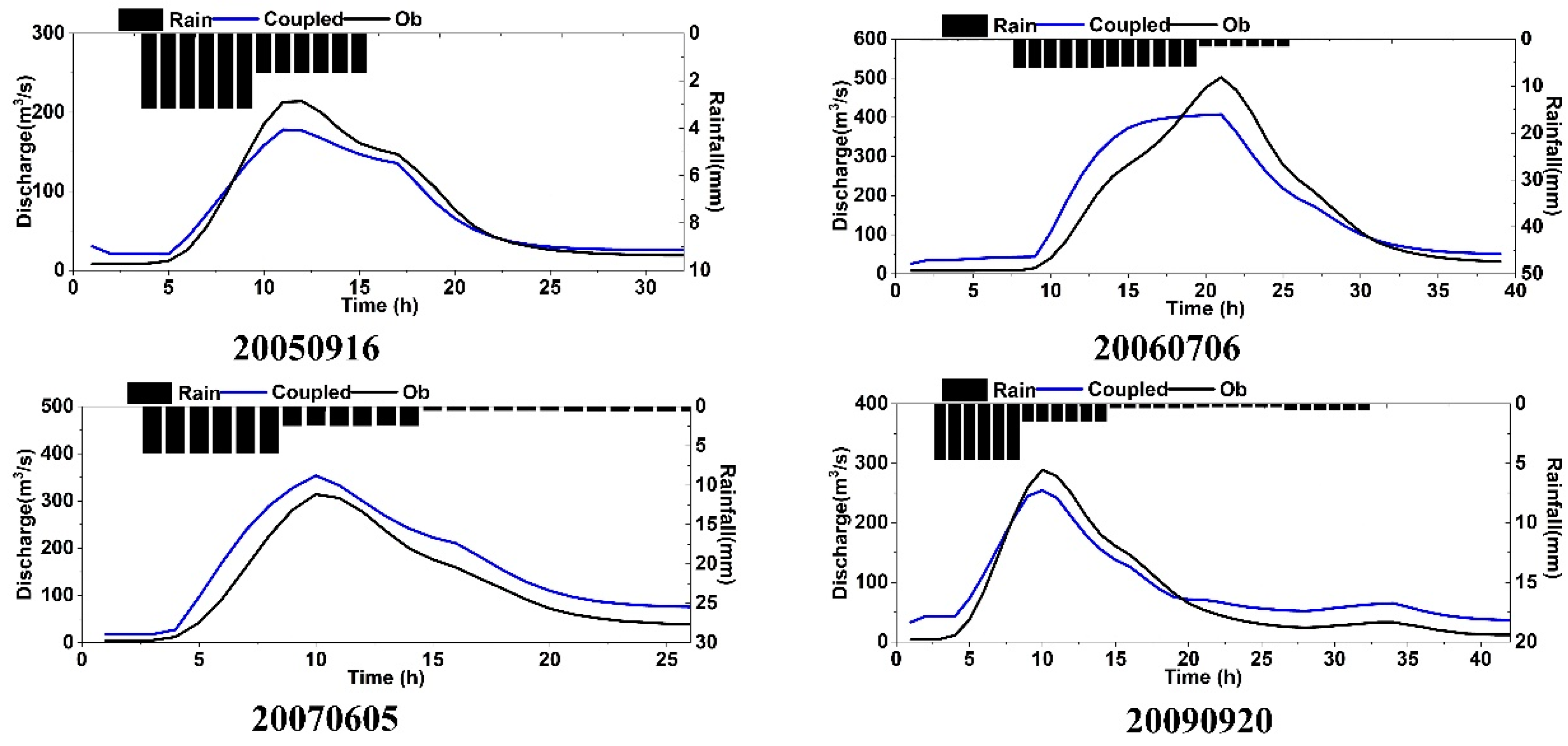
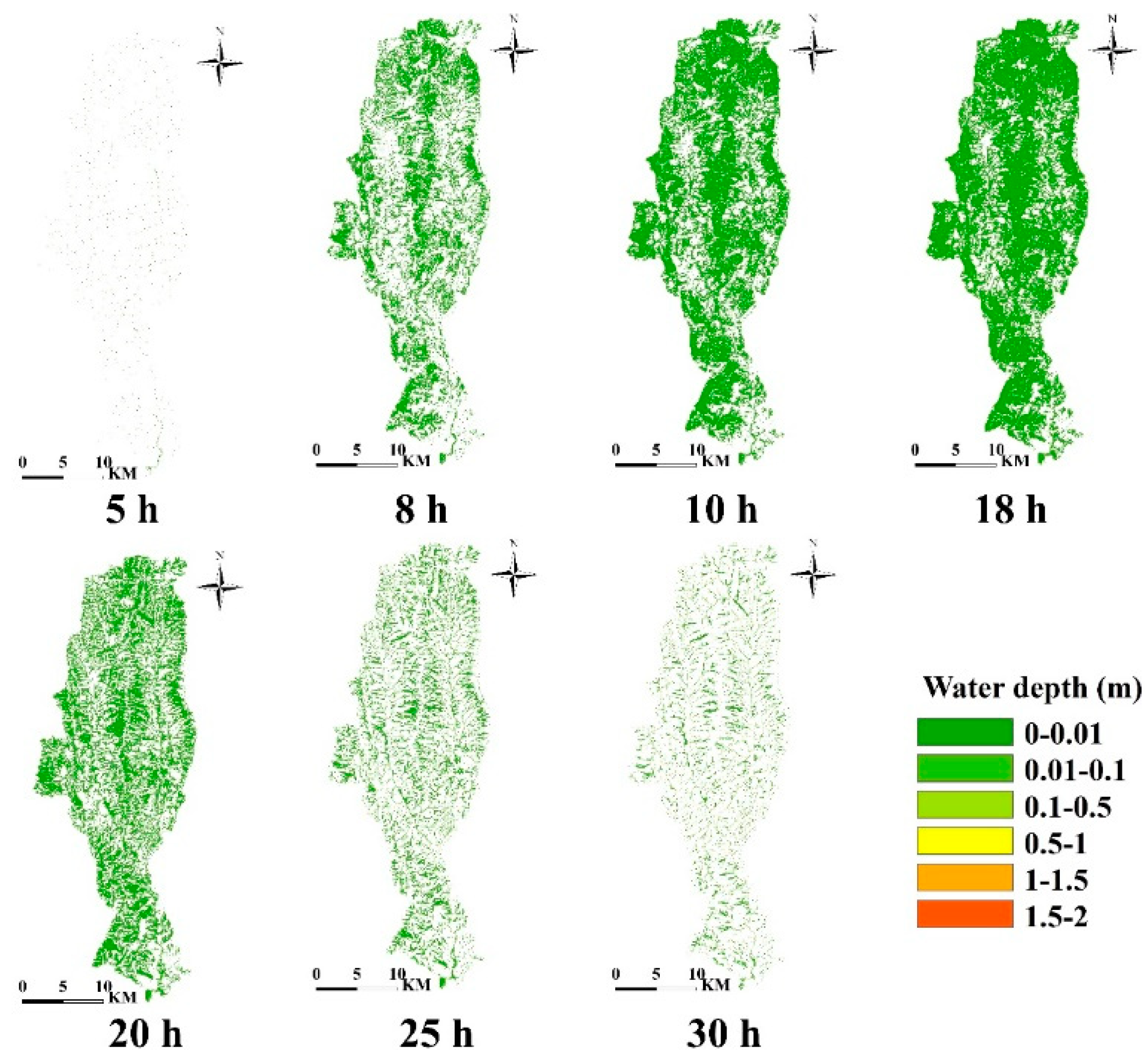

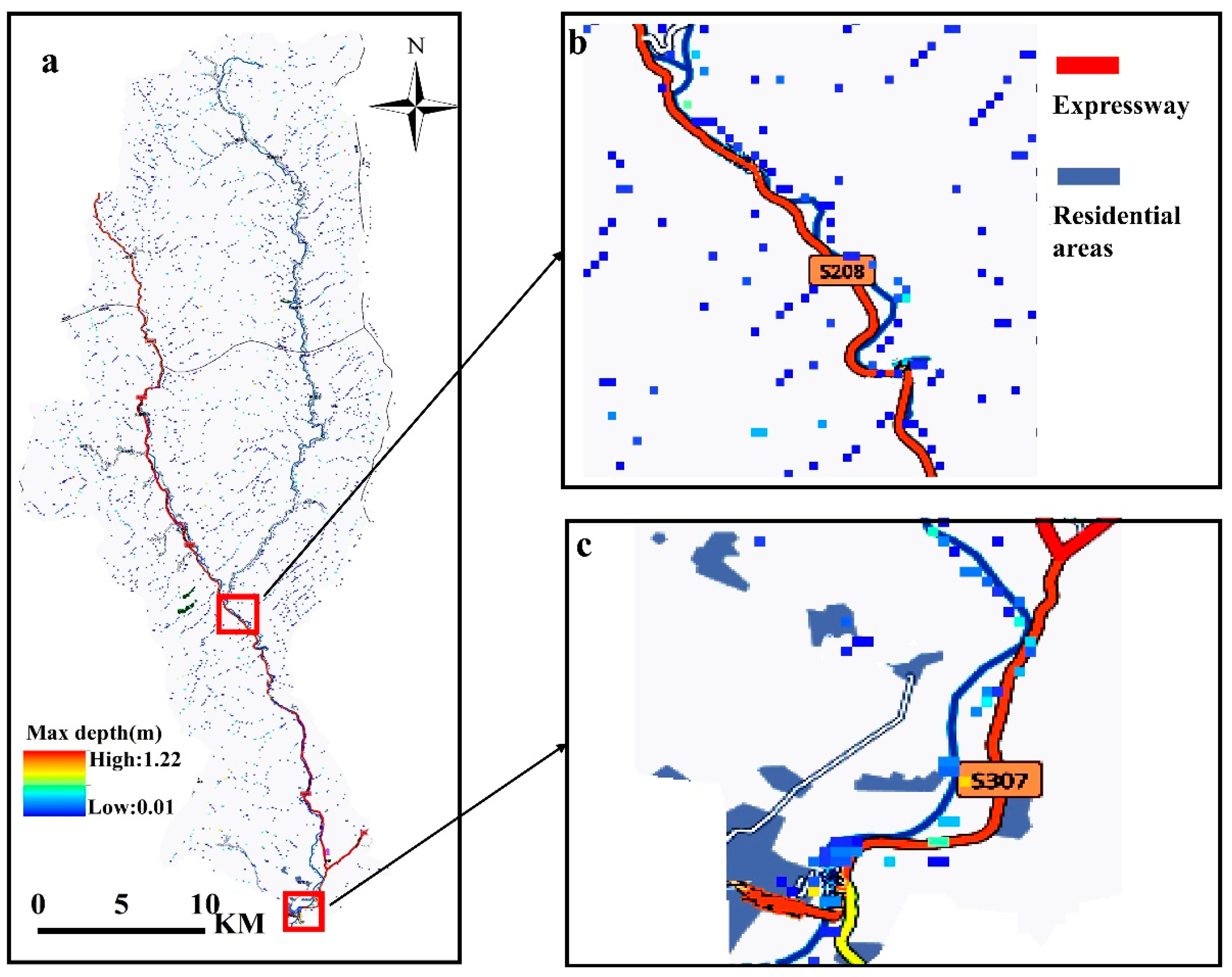
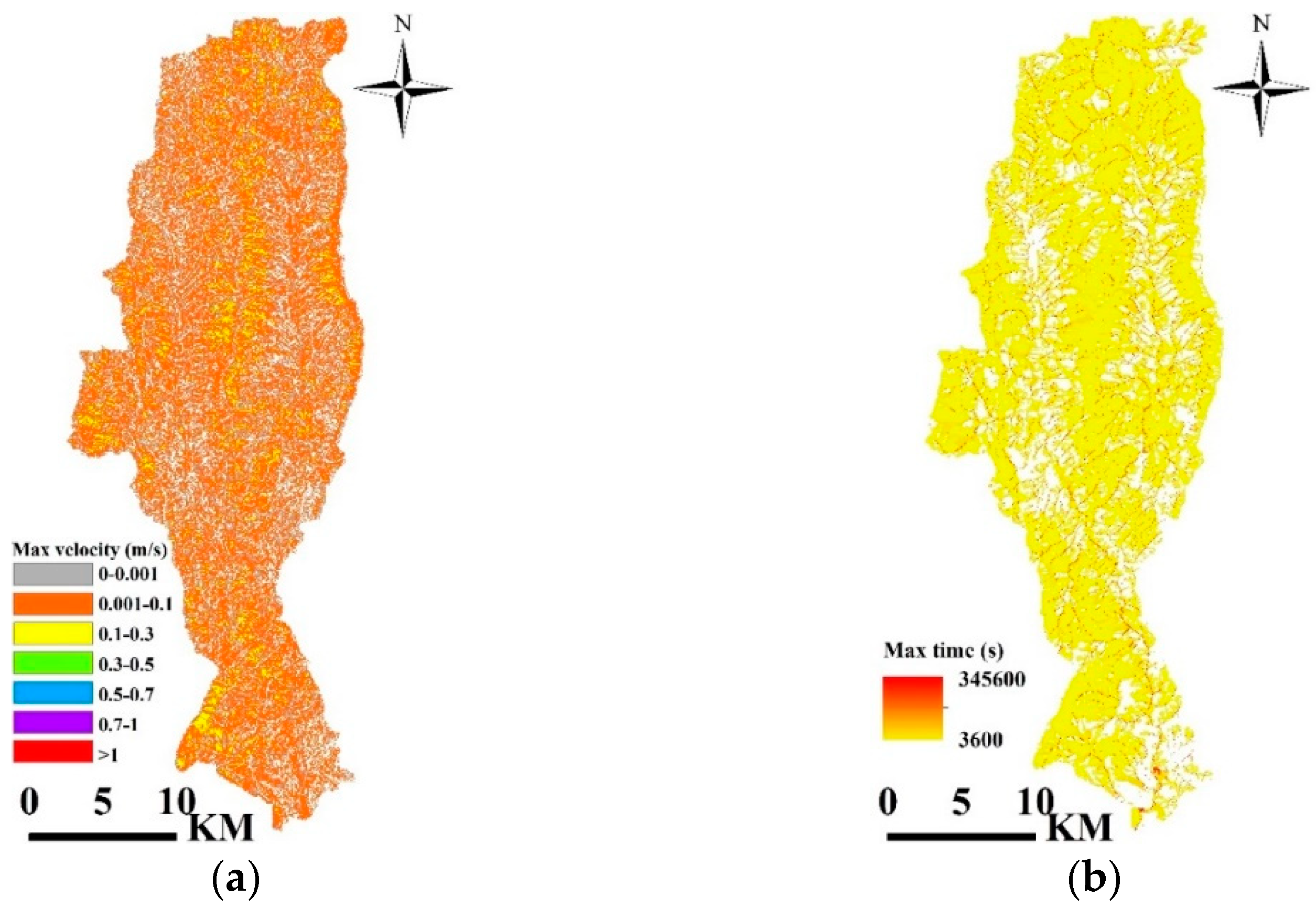

| Data | Description | Source | Purpose |
|---|---|---|---|
| Rainfall (mm) Discharge (m3/s) | Hourly: (Flood data (2005–2010)) Monthly: ERA5 (2005–2010) | Hourly: hydrological administrations Zhaojue station (28.00° N,102.85° E) Monthly: Climate Forecasting Application Network from the European Centre for Medium-Range Weather Forecast (ECMWF) | Hourly: Model calibration/ validation Monthly: Hydrology analysis (Section 3.1) |
| Evaporation (mm) | Hourly: (Flood data (2005–2010)) | Hydrological administration Zhaojue station (28.00° N, 102.85° E) | Model calibration/ validation |
| Temperature (°C) | Daily: 2005–2010 0.25˚ × 0.25˚ ERA5 precipitation and temperature data with a temporal resolution of 1 h | Climate Forecasting Application Network from the European Centre for Medium-Range Weather Forecast (ECMWF) | Hydrology analysis (Section 3.1) |
| Regional map (River network stations) | Vector format GCS_WGS_1984 1:50,000 | Bureau of hydrology | Correction of delineated catchment boundaries and river network |
| Digital Elevation Model (FABDEM) | 30 m × 30 m Publication date: 17 Dec 2021 GCS_WGS_1984 31.52°–32.72° N, 113.25°–114.77° E | University of Bristol https://data.bris.ac.uk/data/dataset/ (accessed on 8 April 2022 ) | FABDEM is new a global elevation map that removes building and tree height Delineation of catchment boundaries Extraction of river network and floodplain cross-sections Input data for the hydraulic module of the coupled model |
| Landsat 4-5 TM | 30 m × 30 m 2005-2010 (June) GCS_WGS_1984 | United States Geological Survey (USGS) (https://eartheplorer.usgs.gov accessed on 10 April 2022) | Land use classification Assigning the surface flow to basin grids Determining the Manning coefficient as the input data for the hydraulic module of the coupled model |
| 30 m × 30 m | |||
| Google Earth | Raster format 2006 | Google LLC | The base map of flood hazard map |
| Land Use | Manning’s Coefficient (s/m1/3) |
|---|---|
| Urban land | 0.016 |
| Water | 0.035 |
| Grassland | 0.03 |
| Cultivated land | 0.035 |
| Forest land | 0.075 |
| Parameters | Physical Meaning | Range and Units [93,94,95] | Optimized Value | |
|---|---|---|---|---|
| Evapotranspiration | K | Ratio of potential evapotranspiration to pan evaporation | 0.5–1.1 (−) | 0.91 |
| C | Coefficient of the deep layer | 0.1–0.3 (−) | 0.2 | |
| WUM | Averaged soil moisture storage capacity of the upper layer | 5–100 (mm) | 5 | |
| WLM | Averaged soil moisture storage capacity of the lower layer | 50–300 (mm) | 86 | |
| WDM | Averaged soil moisture storage capacity of the deeper layer | 5–100 (mm) | 35 | |
| Runoff generation | B | Exponent of the distribution to tension water capacity | 0.1–2 (−) | 0.34 |
| IMP | Percentage of impervious and saturated areas in the basin | 0.01–0.1 (%) | 0.01 | |
| Runoff sources partition | SM | Areal mean free water capacity of the surface soil layer | 5–100 (mm) | 85 |
| EX | Exponent of the free water capacity curve influencing the development of the saturated area | 1–1.5 (−) | 1.5 | |
| Runoff routing | KSS | Outflow coefficients of the free water storage to interflow relationships | 0.01–0.7 | 0.23 |
| KG | Outflow coefficients of the free water storage to groundwater relationships | 0.01–0.7 (−) | 0.47 | |
| KKI | Recession constants of the interflow storage | 0.05–0.95 (−) | 0.74 | |
| KKG | Recession constants of the groundwater storage | 0.9–0.999 (−) | 0.998 |
| Land Use Type | Cultivated Land | Forest | Grassland | Water | Unused | Urban Land |
|---|---|---|---|---|---|---|
| Area percentage (%) | 15.03 | 41.63 | 43.04 | 0.1 | 0.01 | 0.19 |
| Flood | NSE | RE (%) | PE (%) | ΔT (h) | |
|---|---|---|---|---|---|
| Calibration | 20050707 | 0.77 | −25.76 | −42.90 | 1 |
| 20050916 | 0.95 | −4.02 | −16.83 | 2 | |
| 20060706 | 0.87 | 6.74 | −18.82 | 1 | |
| 20060917 | 0.67 | 28.50 | −0.15 | 1 | |
| 20070605 | 0.80 | 33.95 | 12.64 | 1 | |
| 20070916 | 0.76 | −10.06 | 3.10 | 1 | |
| Validation | 20080703 | 0.77 | 22.37 | −8.41 | 1 |
| 20090726 | 0.94 | 1.22 | −15.32 | 1 | |
| 20090920 | 0.90 | 16.75 | −12.00 | 1 | |
| 20100821 | 0.48 | 81.92 | 3.88 | 2 |
| Depth (m) | Inundation Area (km2) | Area Ratio (%) |
|---|---|---|
| [0.05, 0.1) | 5.17 | 1.00 |
| [0.1, 0.2) | 2.80 | 0.54 |
| [0.2, 0.4) | 1.27 | 0.25 |
| [0.4, +∞) | 0.47 | 0.09 |
Publisher’s Note: MDPI stays neutral with regard to jurisdictional claims in published maps and institutional affiliations. |
© 2022 by the authors. Licensee MDPI, Basel, Switzerland. This article is an open access article distributed under the terms and conditions of the Creative Commons Attribution (CC BY) license (https://creativecommons.org/licenses/by/4.0/).
Share and Cite
Xu, C.; Fu, H.; Yang, J.; Wang, L. Assessment of the Relationship between Land Use and Flood Risk Based on a Coupled Hydrological–Hydraulic Model: A Case Study of Zhaojue River Basin in Southwestern China. Land 2022, 11, 1182. https://doi.org/10.3390/land11081182
Xu C, Fu H, Yang J, Wang L. Assessment of the Relationship between Land Use and Flood Risk Based on a Coupled Hydrological–Hydraulic Model: A Case Study of Zhaojue River Basin in Southwestern China. Land. 2022; 11(8):1182. https://doi.org/10.3390/land11081182
Chicago/Turabian StyleXu, Chaowei, Hao Fu, Jiashuai Yang, and Lingyue Wang. 2022. "Assessment of the Relationship between Land Use and Flood Risk Based on a Coupled Hydrological–Hydraulic Model: A Case Study of Zhaojue River Basin in Southwestern China" Land 11, no. 8: 1182. https://doi.org/10.3390/land11081182
APA StyleXu, C., Fu, H., Yang, J., & Wang, L. (2022). Assessment of the Relationship between Land Use and Flood Risk Based on a Coupled Hydrological–Hydraulic Model: A Case Study of Zhaojue River Basin in Southwestern China. Land, 11(8), 1182. https://doi.org/10.3390/land11081182






